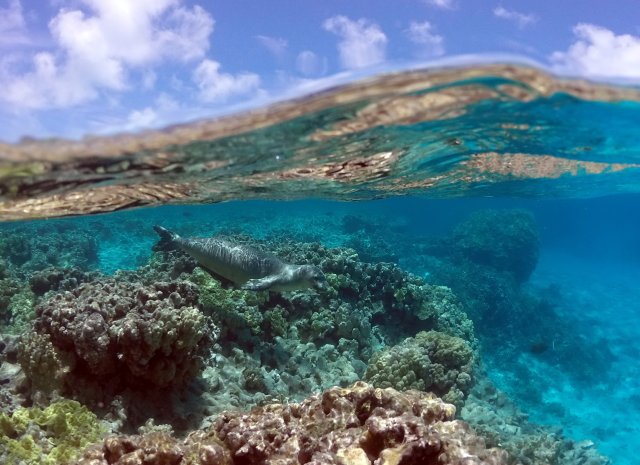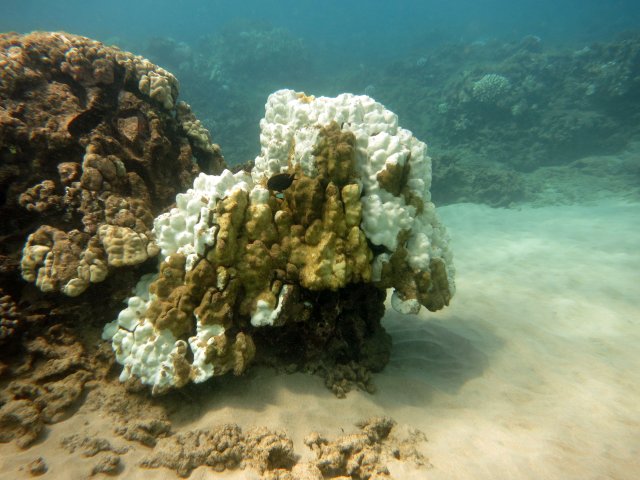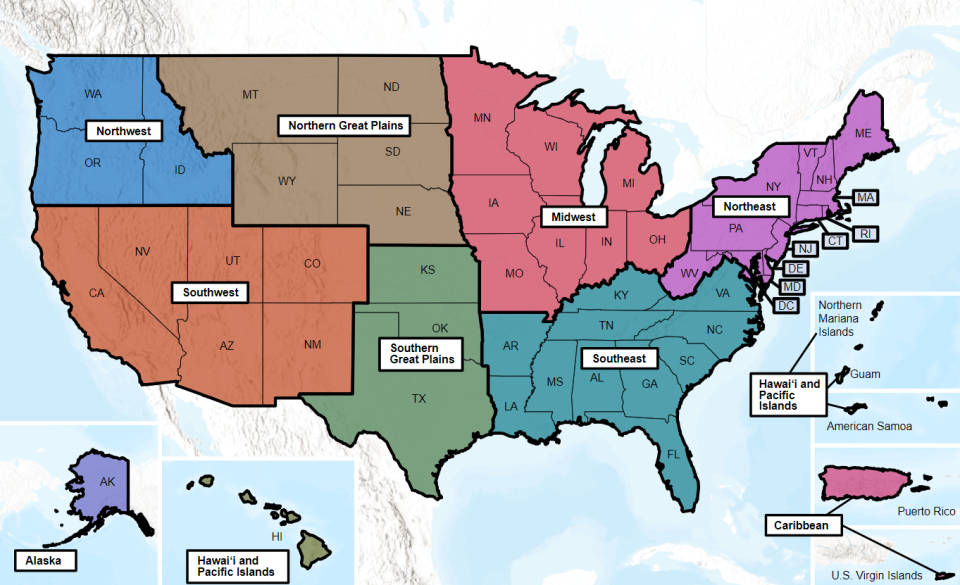Climate Change Connections: Hawai‘i (Coral Reefs)
Climate change is impacting all regions and sectors of the United States. The State and Regional Climate Change Connections resource highlights climate change connections to culturally, ecologically, or economically important features of each state and territory. The content on this page provides an illustrative example. As climate change will affect each state and territory in diverse ways, this resource only describes a small portion of these risks. For more comprehensive information about regional climate impacts, please visit the Fifth National Climate Assessment and Climate Change Impacts by Sector.
On this page:
Introduction: Hawai‘i’s Coral Reefs Are Culturally, Ecologically, and Economically Significant

Hawai‘i’s coral reefs support a remarkably diverse community of fish, birds, marine mammals, and other flora and fauna, many of which are uniquely found in the Hawaiian Islands. Nearly a quarter of the species in Papahānaumokuākea Marine National Monument, one of the largest marine protected areas in the world, are only found in the Hawaiian Archipelago.1,2 Numerous rare and endangered species, such as the Hawaiian monk seal (ʻīlio holo i ka uaua), green sea turtles (honu), and hawksbill sea turtles (honu ‘ea) depend on Hawai‘i’s reefs for their food and habitat.3
Many Native Hawaiians have a deep connection to corals. A widespread belief considers corals to be the beginning of life and to possess mana, or the essence of spirituality.4
Reefs provide numerous and diverse economic and protective benefits. Reefs help break ocean waves, slowing them down before they crash into the shoreline. In Hawaiʻi, healthy reefs provide coastline protection from flooding to thousands of residents, helping prevent millions of dollars in damage each year.5 Reefs also support tourism, as well as recreation opportunities like snorkeling and their associated economies.
Climate Impacts: Climate Change Threatens Coral Reefs with Warming Ocean Temperatures and Ocean Acidification

On a local scale, coral reefs can face threats such as nutrient runoff pollution, physical destruction, and overfishing. Globally, climate change impacts such as warming ocean temperatures, rising sea levels, changing storm patterns and precipitation, and ocean acidification further threaten corals.6 If greenhouse gas emissions are not reduced, environmental conditions are projected to be unsuitable for most of the world’s remaining coral reefs by 2050.7
Warming sea surface temperatures and marine heatwaves are increasing the frequency and severity of coral bleaching events.8 Coral bleaching happens when stressed corals expel the algae (zooxanthellae) that produce their food, which causes the coral to turn white and become more vulnerable to disease. During a 2014 bleaching event in Hawaiʻi, 80 percent of the dominant corals in Kaneohe Bay, Oʻahu, were bleached.9 While coral reefs can regrow after bleaching, recovery can take decades.10 The increasing frequency of coral bleaching events can lead to insufficient recovery time. When coral bleaching leads to reef mortality, it can decrease habitat for many species that are supported by healthy reefs.
In addition to warming temperatures, ocean acidification poses a major threat to corals. Oceans are becoming more acidic due to large amounts of carbon dioxide being absorbed into the ocean.11,12 Carbon dioxide reacts with sea water to produce carbonic acid and the resulting increase in acidity (measured by lower pH values) changes the chemistry in the water. This makes it more difficult for corals, some types of plankton, and other creatures to produce a mineral called calcium carbonate, which is the main ingredient in their hard skeletons or shells. The loss of healthy coral reefs can lead to broader changes in the overall structure of ocean and coastal ecosystems, ultimately affecting fish populations and the people who depend on them. Given the critical role coral plays in shore protection, the further degradation of coral reefs can cause millions of dollars in damages.8
Taking Action: Supporting Coral Reef Resilience
Addressing climate change requires reducing greenhouse gas emissions while preparing for and protecting against current and future climate impacts. Communities, public officials, and individuals in every part of the United States can continue to explore and implement climate adaptation and mitigation measures. In Hawaiʻi, a variety of stakeholders are collaborating on research, conservation, and outreach and education measures to protect coral reef health in a changing climate, including:

- Monitoring and planning. Scientists use a suite of tools to track near-real-time conditions and continuously monitor long-term trends in ocean conditions for coral reefs. For example, NOAA’s Coral Reef Watch, which has successfully predicted all major bleaching events around the world since 1997, provides an early warning system for coral bleaching.13 The Hawai‘i Division of Aquatic Resources collaborates with local partners to survey and assess coral bleaching.14 In response to global coral bleaching events in 2014 and 2015, the Hawai‘i Department of Land and Natural Resources worked with many stakeholders to develop a Coral Bleaching Recovery Plan (pdf) (4.8 MB).15 The Hawai‘i Department of Land and Natural Resources also published Hawaiʻi Coral Reef Strategy 2030: Ecosystem Planning Priorities in the Main Hawaiian Islands to support the state’s vision to “ensure thriving, diverse, resilient coral reefs that sustain valuable ecosystem services for present and future generations.”16
- Marine conservation. Maintaining and enhancing marine managed areas, which are protected areas where human activity is limited, could help increase local marine populations’ resilience to climate-related stressors.17 The Division of Aquatic Resources currently manages several Marine Managed Areas around the Hawaiian Islands.18 The Papahānaumokuākea Marine National Monument and the Hawaiian Islands Humpback Whale National Marine Sanctuary are just two examples of federally protected marine areas and are key to the long-term protection of Hawai‘i’s natural and cultural resources. The state of Hawaiʻi’s Marine 30×30 Initiative aims to effectively manage waters near Hawai‘i’s shores by designating 30 percent of these waters as marine management areas by 2030.19
- Propagation. Restoring corals using coral propagation is relatively new effort in Hawai‘i.20 NOAA and other marine research institutes are exploring innovative approaches to growing and maintaining coral species that can adapt to changing climate and marine conditions.20,21 The state of Hawaiʻi’s Coral Restoration Nursery takes an innovative approach to mitigating damage to coral reefs and fostering restoration. At the land-based coral nursery, small corals are used to quickly grow large coral colonies. These colonies are then planted in damaged and degraded reefs.22
- Outreach and education. Education campaigns from state and federal agencies encourage individual visitor behaviors that help protect coral reefs. For example, the National Park Service highlights the importance of choosing reef-safe sunscreen.23 NOAA also supports a Coral Reef Conservation Program that works to directly address climate change impacts on coral reefs in Hawaiʻi and elsewhere.24
To learn more about climate change impacts in Hawaiʻi and other U.S.-affiliated Pacific islands, see Chapter 30 of the Fifth National Climate Assessment.
Related Resources
- America’s Coral Reefs (EPA)
- EPA Climate Change Indicators: Ocean Acidity
- EPA Climate Change Indicators: Ocean Heat
- EPA Climate Change Indicators: Sea Surface Temperatures
- Hawaiʻi State Climate Summary 2022 (NOAA)
- NOAA Coral Reef Conservation Program (NOAA)
- How Does Climate Change Affect Coral Reefs? (NOAA)
- Climate Change and Ocean Acidification (NOAA)
References
1 NOAA National Ocean Service. (2022). Papahānaumokuākea Marine National Monument. https://www.papahanaumokuakea.gov/wheritage/endemic.html
2 NOAA Fisheries. (2018). Papahānaumokuākea Marine National Monument. Habitat Conservation. Retrieved July 25, 2024, from https://www.fisheries.noaa.gov/pacific-islands/habitat-conservation/papahanaumokuakea-marine-national-monument
3 NOAA. (2022). Papahānaumokuākea as a refuge for rare and globally significant species. Papahānaumokuākea Marine National Monument. https://www.papahanaumokuakea.gov/wheritage/refuge.html
4 Gregg, T. M., Mead, L., Burns, J. H. R., & Takabayashi, M. (2015). Puka Mai He Ko‘a: The significance of corals in Hawaiian culture. In N. Narchi & L. L. Price (Eds.), Ethnobiology of Corals and Coral Reefs (pp. 103–115). Springer International Publishing. https://doi.org/10.1007/978-3-319-23763-3_7
5 U.S. Geologic Survey. (2019). The value of US coral reefs for risk reduction - Hawaiʻi. https://www.usgs.gov/media/images/value-us-coral-reefs-risk-reduction-hawaii
6 EPA Office of Water. (2017). Threats to coral reefs (Florida, Hawaii, Texas, American Samoa, Guam, Northern Mariana Islands, Puerto Rico, U.S. Virgin Islands). Coral Reefs. Retrieved December 22, 2023, from https://www.epa.gov/coral-reefs/threats-coral-reefs
7 Setter, R. O., Franklin, E. C., & Mora, C. (2022). Co-occurring anthropogenic stressors reduce the timeframe of environmental viability for the world’s coral reefs. PLOS Biology, 20(10), e3001821. https://doi.org/10.1371/journal.pbio.3001821
8 Frazier, A. G., Johnson, M.-V. V., Fortini, L. B., Giardina, C. P., Grecni, Z. N., Kane, H. H., Keener, V. W., King, R., MacKenzie, R. A., Nobrega-Olivera, M., Oleson, K. L. L., Shuler, C. K., Singeo, A. K., Storlazzi, C. D., Wallsgrove, R. J., & Woodworth-Jefcoats, P. A. (2023). Ch. 30. Hawaiʻi and US-affiliated Pacific islands. In A. R. Crimmins, C. W. Avery, D. R. Easterling, K. E. Kunkel, B. C. Stewart, & T. K. Maycock (Eds.), Fifth National Climate Assessment. U.S. Global Change Research Program. https://doi.org/10.7930/NCA5.2023.CH30
9 NOAA. (2015). From coral bleaching to signs of recovery in Hawaii. https://coralreef.noaa.gov/aboutcrcp/news/featuredstories/feb15/cbleachhawaii.html
10 State of Hawaii Department of Land and Natural Resources. (n.d.). Coral impacts. Reef Response. Retrieved December 22, 2023, from https://dlnr.hawaii.gov/reefresponse/home/coral-impacts/
11 NOAA. (2020). Ocean acidification. Retrieved October 29, 2023, from https://www.noaa.gov/education/resource-collections/ocean-coasts/ocean-acidification
12 EPA. (n.d.). An introduction to ocean and coastal acidification. Retrieved December 22, 2023, from https://www.epa.gov/ocean-acidification/introduction-ocean-and-coastal-acidification
13 NOAA National Environmental Satellite, Data, and Information Service. (n.d.). Coral Reef Watch satellite monitoring and modeled outlooks. Coral Reef Watch. Retrieved December 22, 2023, from https://coralreefwatch.noaa.gov/satellite/index.php
14 State of Hawaii Division of Aquatic Resources. (n.d.). Coral bleaching. Retrieved July 25, 2024, from https://dlnr.hawaii.gov/dar/coral-bleaching/
15 Hawaiʻi Department of Land and Natural Resources, Division of Aquatic Resources. (2017). Coral bleaching recovery plan. https://dlnr.hawaii.gov/dar/files/2017/04/Coral_Bleaching_Recovery_Plan_final.pdf
16 State of Hawaii Department of Land and Natural Resources Division of Aquatic Resources. (n.d.). Hawaii coral reef strategy 2030. https://dlnr.hawaii.gov/coralreefs/files/2020/08/Hawaii-Coral-Reef-Strategy-2030-Final.pdf
17 Micheli, F., Saenz-Arroyo, A., Greenley, A., Vazquez, L., Espinoza Montes, J. A., Rossetto, M., & De Leo, G. A. (2012). Evidence that marine reserves enhance resilience to climatic impacts. PLOS ONE, 7(7), e40832. https://doi.org/10.1371/journal.pone.0040832
18 State of Hawaii Division of Aquatic Resources. (n.d.). About marine managed areas. Retrieved July 25, 2024, from https://dlnr.hawaii.gov/dar/marine-managed-areas/about-marine-managed-areas/
19 Hawaii Department of Land and Natural Resources, Division of Aquatic Resources. (2022). Holomua: Marine 30×30.
20 NOAA Fisheries. (2021). Restoring coral reefs (Pacific Islands, Southeast). Habitat Conservation. Retrieved December 22, 2023, from https://www.fisheries.noaa.gov/national/habitat-conservation/restoring-coral-reefs
21 Lebrec, M., Stefanski, S., Gates, R., Acar, S., Golbuu, Y., Claudel-Rusin, A., Kurihara, H., Rehdanz, K., Paugam-Baudoin, D., Tsunoda, T., & Swarzenski, P. W. (2019). Ocean acidification impacts in select Pacific Basin coral reef ecosystems. Regional Studies in Marine Science, 28, 100584. https://doi.org/10.1016/j.rsma.2019.100584
22 Hawaii Department of Land and Natural Resources. (n.d.). Hawai‘i coral restoration nursery. Retrieved February 16, 2024, from https://dlnr.hawaii.gov/coralreefs/hawaii-coral-restoration-nursery/
23 National Park Service. (n.d.). Reef-friendly sun protection campaign graphics. Oceans, Coasts & Seashores. Retrieved July 25, 2024, from https://www.nps.gov/subjects/oceans/reeffriendlycampaigngraphics.htm
24 NOAA Coral Reef Conservation Program. (n.d.). The Coral Program’s climate change & reef resilience activities. NOAA Coral Reef Information System (CoRIS). Retrieved December 22, 2023, from https://www.coris.noaa.gov/activities/projects/climate/

